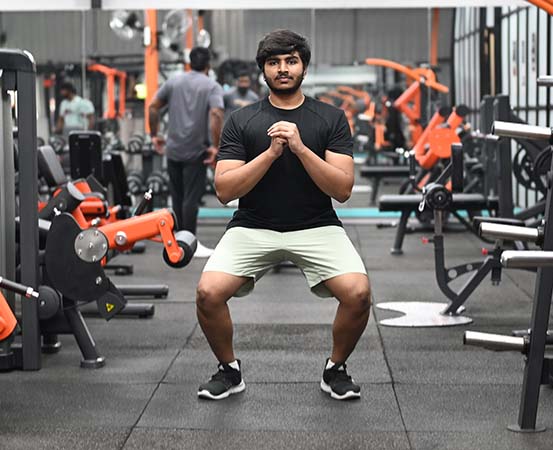
Squats, in their simplest form with no added weights, are among the first exercises one might do while hitting the gym or starting a strength training routine. This compound bodyweight exercise is one of the easiest to perform and master. Moreover, the benefits of squats are manifold. The ease of learning this is possibly because squatting is one of the most natural movements known to humans — done since toddlerhood, before one even learns to walk.
Most daily activities — standing from a seated position, jumping, picking up objects from the floor — all involve squatting. As we grow, and especially with the sedentary lifestyle the world has moved on to, most lose touch with this natural movement. As a result, we invariably get the squatting technique or biomechanics wrong while getting back to it later in life. Getting the squatting technique right is paramount to reap its benefits fully, and also to prevent injuries while doing the exercise and its many complex and intense variations, say experts.
What is the correct squatting technique?
“To perform squats, you must keep the legs shoulder-width apart, with the toes pointing forward,” informs Tanuja Panda, a fitness trainer from Bengaluru. “Keeping the back erect and placing the hands on the thighs, you should lower the body, mimicking sitting on a low chair. When the elbows reach the knee, you will be in the appropriate squatting position, where the entire weight comes on the heels and the thighs are parallel to the floor.”
Vijay BV, founder of Quadz Fitness, Bengaluru, says, a tweak in the technique can help beginners get the form right. “Elevating your heels by 4-5 mm by placing a plate or wooden base for support, makes it easier to squat,” explains Vijay. “It works the quadriceps more, too. While there are several variations of squatting, the technique remains the same throughout. Keeping the elbows aligned next to the body and inhaling as you go down along with the gravity and exhaling as you lift your bodyweight against gravity is crucial.”
Does squatting differ from person to person?
Like all exercises, squatting has a basic technique or protocol that needs to be followed. However, the correct position can vary slightly from one person to another depending on their physical parameters, including the type of feet, length of the lower body, injuries, or discomfort while squatting in a certain position.
“To find the correct squatting posture for yourself, try squatting by placing the feet at different distances, with the knees and toes pointing inwards, outwards, etc.,” shares Sunil Kumar, a fitness trainer from Bengaluru. “When you are in the squatting position that works best for you, you should not feel any restriction in movement along the pelvis, knee and ankle joints. If you do feel a restriction, alter the position and find the one that allows you to squat comfortably.”
Squats must be performed to the full range of motion unless it is necessary to limit it. Once one starts restricting the movement to partial or half squats, it becomes very difficult to get back to performing a full squat.
Muscles used in squats
Squats are the most popular exercise for strength and conditioning. They form an important part of the exercise programs in military and sports training, as well as most fitness routines. This is because several muscle groups are utilized in a single movement.
“In bodyweight squats, the muscles in the entire lower half of the body, including the glutes, quadriceps, hamstrings, calf muscles, hip flexors and extensors are worked,” explains Kumar. “The core or the muscles in the abdomen and lower back function as the stabilizers.”
Benefits of squatting
Squatting has multiple benefits. As it is a strength-training compound exercise, it increases the strength and mobility of the entire body.
“If you are looking to strengthen the core, you should limit yourself to doing planks or other workouts. But leg workouts that include squats are very important to activate the core muscles,” shares Panda. “The number of muscles that squatting engages makes it easier to burn calories. Doing squats regularly also increases the mobility and range of motion along the hip, knee and ankle joints.” Lifting weights while squatting helps build greater strength in the spine, core and lower body while increasing flexibility.
“Your entire posture can be corrected by doing squats,” highlights Vijay. “People with knee pain can do a shoulder-width squat, with the toes pointing outwards, forming a V-shape and an elevated support at the heel. This decreases the pressure and impact on the knees, making it much easier and more comfortable to squat despite the pain.” Moreover, as a functional movement, squats enhance your quality of life by helping you maintain the right posture while doing daily activities like sitting, walking, jogging, running and bending. This, in turn, reduces the risk of injuries.
Takeaways
- Squatting is a functional movement. It also helps maintain correct posture during various daily activities, such as sitting, standing, walking and picking up things from the floor.
- The many variations notwithstanding, the basic technique of doing squats remains the same.
- Squats mostly work muscles in the lower body, the spinal and para-spinal muscles and core muscles.
















